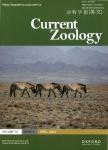The effect of monoamines reuptake inhibitors on aerobic exercise performance in bank voles from a selection experiment
作者机构:Institute of Environ metal Sciences Jagiellonian University 7 Gronostajowa Street 30-387 Krakow Poland
出 版 物:《Current Zoology》 (动物学报(英文版))
年 卷 期:2019年第65卷第4期
页 面:409-419页
核心收录:
学科分类:0710[理学-生物学] 07[理学] 09[农学]
基 金:supported by the National Science Centre in Poland the Jagiellonian University
主 题:experimental evolution monoamines motivation physical activity selective breeding voluntary exercise
摘 要:Exercise performance depends on both physiological abilities (e.g., muscle strength) and behavioral characteristics (e.g., motivati on). We tested the hypothesis that evoluti on of in creased aerobic exercise performanee can be facilitated by evolution of neuropsychological mechanisms responsible for motivation to undertake physical activity. We used a unique model system: lines of bank voles Myodes glareolus selected for high swim-induced aerobic metabolism (aerobic A lines). In gen eration 21, voles from the 4 A lines achieved a 57% higher /y voluntary maximum swiminduced aerobic metabolism (V02swim) than voles from 4 unselected,control C lines. In C lines, V02swim was 9% lower than the maximum forced-exercise aerobic metabolism (VO2run;P= 0.007), while in A lines it was even higher than VO2run, although not significantly (4%, P=0.15). Thus, we hypothesized that selection changed both the aerobic capacity and the neuronal mechanisms behi nd motivation to un dertake activity. We investigated the influe nee of reuptake in hibitors of dopamine (DARI), serotonin (SSRI), and norepinephrine (NERI) on VOaSwim. The drugs decreased V02swim both in C and A lines (% decrease compared with saline: DARI 8%, P 0.001;SSRI 6%, P 0.001;NERI 8%, P 0.001), but the proportional response differed between selection directions only for NERI (stronger effect in C lines: P= 0.008) and the difference was marginally non-significant for SSRI (P= 0.07) and DARI (P= 0.06). Thus, the results suggest that all the 3 monoamines are involved in signaling pathways controlling the motivation to be active and that norepinephrine could have played a role in the evolution of increased aerobic exercise performance in our animal model.



